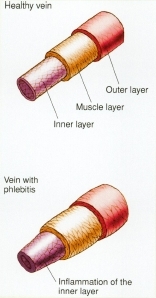Phlebitis
Phlebitis (fle-BY-tis) is inflammation of a vein that can lead to blood clots.
KEYWORD
for searching the Internet or other reference sources
Circulatory system
Terry's Tale
Terry decided to visit her doctor because her lower left leg hurt. It also appeared swollen and red and even felt a bit warm to the touch.
As she explained her symptoms to the doctor, he looked concerned. He asked if Terry spent much time sitting. She said that as a receptionist at a busy office, she might go hours without getting up from her desk.
Because she spent a lot of time sitting down and her leg was red and swollen, the doctor suspected that Terry had phlebitis.
An Unseen Danger
Veins return blood from parts of the body to the heart. The heart beats about 100,000 times a day, driving blood through the arteries of the body and back to the heart through the veins.
Sometimes, however, the blood in veins does not flow well. It moves slowly or pools, like water sitting in a puddle. This can happen for many reasons. As in Terry's case, too much sitting at work (or on long car or plane rides) can restrict blood flow in the legs. Also, an injury, tumor, or surgery can cause damage to veins that slows blood flow. Ill people who have to spend a lot of time in bed are prone to pooling of blood in veins. Pregnant women also are at greater than normal risk, as are women who take estrogen, a female hormone in birth control pills and pills used by women after menopause * . Smoking is another major risk factor.
The pooling of blood causes the walls of the vein to stretch and become inflamed. It also can cause clotting. Clots are thick masses of blood that usually have a beneficial function, such as when they stop a cut from bleeding. But when clots form inside veins, the condition is called thrombosis. If the clot breaks free, it can cause an embolism, which occurs when a clot travels through the bloodstream and blocks the blood supply to the lungs or other organs. This can cause severe problems, including sudden death.
Phlebitis usually occurs in legs, although it can occur in other body parts. Symptoms include pain, swelling, and redness.
When phlebitis occurs in veins close to the skin, it is called superficial. When it occurs deep inside the leg, it is called deep-vein.

Diagnosis
Doctors use tests to search for clots in the veins. One involves injecting dye into a leg vein and viewing it under an x-ray to reveal clots. Doctors also can use an ultrasound machine to create an image of the leg that is similar to one from an x-ray. Or they can use a machine that measures blood pressure at various points in the leg; if it is different above and below the suspected clot, it could mean that the vein is blocked.
* menopause (MEN-o-pawz) is the time of life when women stop menstruating (having their monthly period) and can no longer become pregnant.
Treatment
The danger of phlebitis is that it will develop into thrombosis. If no clot is present, doctors treat patients with heat packs and anti-inflammatory drugs such as ibuprofen and have the person raise the affected leg to encourage better blood flow. Doctors may prescribe blood-thinning drugs such as heparin or warfarin to dissolve clots or to prevent their formation. They also monitor patients to ensure that clots do not form in the future.
Prevention
The best prevention is staying active. Also, smoking and being over-weight increase the risk of phlebitis and thrombosis, so it is wise to avoid tobacco and maintain healthy weight.
See also
Heart Disease
Thrombosis
Comment about this article, ask questions, or add new information about this topic: